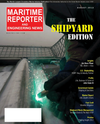
Page 32: of Maritime Reporter Magazine (August 2012)
The Shipyard Edition
Read this page in Pdf, Flash or Html5 edition of August 2012 Maritime Reporter Magazine
32Maritime Reporter & Engineering News Most every company knows it should have a plan to deal with catastrophe.That?s especially true for shipyards and vessel owners who often ply their trade in hurricane zones, whereweather can rip apart a lifetime of work overnight, make confetti out of assets, and leave disarray in its wake. Emergency plans can be simple or complex, depending on the needs of a specific business. There are a number of resources to help business owners create customized plans, including online tem-plates, detailed guidelines and modeldocuments. A company?s insurance agent and carrier can also serve as useful re- sources for businesses trying to deter- mine what should be in a plan, and how to best position themselves to recover quickly if disaster strikes. A plan by itself, however, is not enough. A company that makes a plan and sticks it on a shelf has taken only the first step toward preparing for a catastro- phe. Based on extensive experience cleaning up after natural disasters over many years, insurance carriers have no- ticed that some businesses bounce back quickly while others have a difficult time recovering. Those that survive most often are the ones that have gone beyond mak- ing a plan, taking extra precautions and thinking through worst-case scenarios. A Plan Is Only As Good As Its Execution The story of one shipyard?s experience with Hurricane Katrina demonstrateswhy having a plan is not always enough. With the storm approaching, a designated crew followed the shipyard?s emergency plan, taking two spud barges and a breast- ing barge deep into a marshy area away from the anticipated path of the hurri- cane.Upon arrival at the designated spot, the crew realized it had not brought the proper lines to secure the breasting barge. With the storm approaching and the yard an hour and a half away, there was no time to do anything other than use the worn lines that were available. The spuds were dropped into place and the breast-ing barge was tied between the two spud barges. Unfortunately, the winds were stronger than the lines. Perhaps even the emer- gency lines, set aside but forgotten, would not have been enough. The breast- ing barge broke free and was blown into an interstate freeway bridge more than a mile away, causing extensive damage and disrupting traffic. Twenty days and almost $6 million later, the bridge was once again opera- tional. However, that was not the only ex- pense. When the waters receded after Katrina died down, the barge was stranded in a shallow area until a canal could be dug to get it back to where it could be floated tothe yard. ?For Want of a Nail? is an old proverb that spells out the chain of circumstanceswhen a horseshoe nail comes loose, thehorse falters, a man is thrown, a battle is lost and a kingdom falls. In this case, for want of a good line, a barge was lost, a bridge was disabled and a shipyard suf- fered. MARINE INSURANCEReady for the Worst Taking Emergency Plans for a Dry Run By Kirk Rider, Ocean Marine Director, Risk Con- trol, & Charlie Pugliese, Ocean Marine Hull & Liabilities Practice Leader, Travelers MR#8 (26-33):MR Template 8/9/2012 3:24 PM Page 32

 31
31

 33
33
